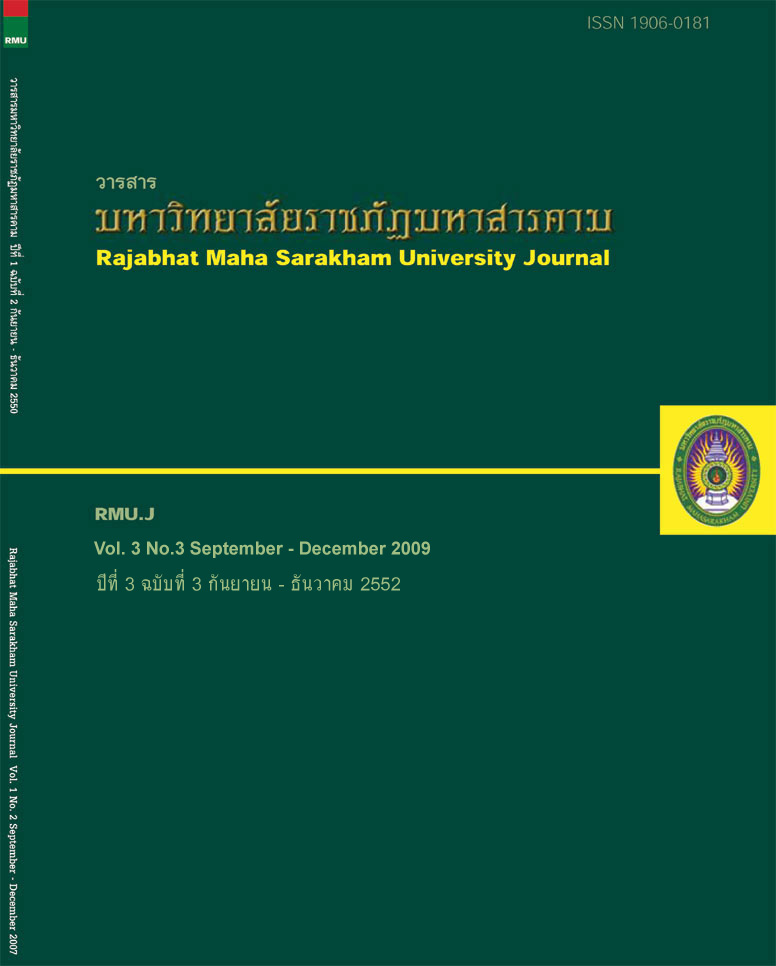การพัฒนาการดำเนินงาน ของสหกรณ์การเกษตร ในภาคตะวันออกเฉียงเหนือ ประเทศไทย The Performance Development of Agricultural Cooperatives in the Northeastern Region of Thailand
Main Article Content
บทคัดย่อ
การศึกษาครั้งนี้มีวัตถุประสงค์ประการแรกเพื่อศึกษาปัจจัยที่มีผลกระทบต่อการดำเนินงานสหกรณ์การเกษตรในภาคตะวันออกเฉียงเหนือ ประการที่สองเพื่อสร้างรูปแบบการพัฒนาการดำเนินงานของสหกรณ์การเกษตรในภาคตะวันออก
เฉียงเหนือ และประการที่สามเพื่อประเมินผลรูปแบบการพัฒนาการดำเนินงานของสหกรณ์การเกษตรในภาคตะวันออกเฉียงเหนือวิธีการการวิจัยแบ่งออกเป็น 3 ระยะ คือ ระยะที่ 1 ศึกษาปัจจัยที่มีผลกระทบต่อการดำเนินงานของสหกรณ์การเกษตร ประชากร
คือ สหกรณ์การเกษตรในภาคตะวันออกเฉียงเหนือ กลุ่มตัวอย่าง จำนวน 320 สหกรณ์ จากการสุ่มตามระดับชั้นใช้แบบสอบถามเก็บรวบรวมข้อมูลจากกลุ่มตัวอย่าง สถิติที่ใช้ทดสอบสมมติฐานได้แก่ การวิเคราะห์จำแนกประเภท(Discriminant analysis) แบบเป็นขั้นตอน (Stepwise method) และ สหสัมพันธ์แคนโนนิคอล (Canonical correlationanalysis) ระยะที่ 2 การสร้างรูปแบบการพัฒนาการดำเนินงานสหกรณ์การเกษตร นำรูปแบบการพัฒนาสหกรณ์ไปขอความคิดเห็นจากผู้มีประสบการณ์ตรง (Critical incident technique) ทางด้านสหกรณ์ แล้วจัดประชุมเชิงปฏิบัติการ 1 วัน โดยเน้นกับกลุ่มที่มีส่วนร่วม (Focus groups) กลุ่มเป้าหมายประกอบด้วย ประธานกรรมการสหกรณ์ 15 คน ฝ่ายจัดการสหกรณ์ 15 คนและจากเจ้าหน้าที่ฝ่ายส่งเสริมสหกรณ์ 15 คน รวมทั้งหมด 45 คน แล้วนำข้อเสนอแนะของแต่ละกลุ่มสรุปเป็นผลการอภิปรายทั้งหมด โดยผู้วิจัยได้รวบรวมข้อเสนอแนะเพิ่มเติมจากการประชุมเชิงปฏิบัติการ ทำการปรับปรุงรูปแบบการพัฒนาสหกรณ์ให้สมบูรณ์ ระยะที่ 3 การประเมินผลรูปแบบการพัฒนาการดำเนินงานของสหกรณ์การเกษตร ผู้วิจัยนำรูปแบบการพัฒนาสหกรณ์
ไปทดลองกับสหกรณ์การเกษตร 9 สหกรณ์ โดยนำผลจากการเก็บข้อมูล งบดุลเปรียบเทียบก่อนการทดลองและหลังการทดลองหลังจากการทดลองได้จัดทำงบดุล งบกำไรขาดทุนของสหกรณ์อีกครั้งหนึ่งโดยเปรียบเทียบข้อมูลจากทรัพย์สิน ทุน เงินรับฝาก
จากสมาชิก ปริมาณธุรกิจ และรายรับของสหกรณ์ ทำการวิเคราะห์ความแปรปรวนหลายตัวแปร ตามแบบวัดซ้ำ (Repeated measuremultivariate analysis of variance : MANOVA) ผลการวิจัยพบว่า 1. ปัจจัยที่มีผลต่อการดำเนินงานของสหกรณ์การเกษตรในภาคตะวันออกเฉียงเหนือ มี 7 ปัจจัย คือ การวางแผน
เงินช่วยเหลือจากรัฐบาล การฝึกอบรม ศักยภาพผู้จัดการสหกรณ์ เงินรับฝาก ศักยภาพกรรมการสหกรณ์ และเงินช่วยเหลือ
พนักงานสหกรณ์ ผู้วิจัยได้คัดเลือกปัจจัยที่สามารถควบคุมได้ 3 ปัจจัย ได้แก่ การวางแผน การฝึกอบรม และเงินรับฝากจาก
สมาชิกสหกรณ์
2. การสร้างรูปแบบการพัฒนาสหกรณ์การเกษตร ได้จัดทำกิจกรรมในการพัฒนาสหกรณ์การเกษตรมี 3 ด้าน
15 กิจกรรม ประกอบด้วย การการวางแผน โดยฝึกอบรมการวางแผนและจัดทำแผนปฏิบัติงาน การฝึกอบรม มี 7 กิจกรรม
ได้แก่ กลุ่มที่ 1 อบรมสมาชิกสหกรณ์ จัดให้มีการฝึกอบรมให้สมาชิกสหกรณ์ได้รู้จักสิทธิ หน้าที่ หลักการ อุดมการณ์ การดำเนิน
ธุรกิจกับสหกรณ์ และระเบียบข้อบังคับที่เกี่ยวข้องกับสมาชิก 1 กิจกรรม กลุ่มที่ 2 อบรมพนักงานสหกรณ์ จัดอบรม 2 กิจกรรม
จัดอบรมการให้บริการที่ดี จัดอบรมการบริหารจัดการ กลุ่มที่ 3 อบรมกรรมการสหกรณ์ จัดอบรมคุณธรรมและจริยธรรม
การบริหารการดำเนินงานสหกรณ์ พ.ร.บ. ข้อบังคับและระเบียบสหกรณ์ จัดอบรม Walk rally กับพนักงานสหกรณ์ 4 กิจกรรม
และการรับฝากเงินจากสมาชิก ให้สหกรณ์ดำเนินการ 8 กิจกรรม ได้แก่ ประชาสัมพันธ์ สร้างความน่าเชื่อถือ ให้บริการที่ดี จัดให้
ฝากเงินจากเงินปันผลเฉลี่ยคืน จ่ายเงินกู้เข้าบัญชีเงินฝาก ฝากเงินจากผลิตผล จัดสัปดาห์การออม และสร้างแรงจูงใจ
3. การประเมินผลรูปแบบการพัฒนาสหกรณ์การเกษตร พบว่า ผลการทดลองหลังจากการดำเนินการตามกิจกรรม
และปรับปรุงการพัฒนาสหกรณ์การเกษตรแล้ว ผลการทดลองมีความแตกต่างกันอย่างมีนัยสำคัญทางสถิติที่ระดับ .05 ซึ่งแสดง
ว่าการดำเนินงานของสหกรณ์การเกษตรที่ทดลองดีขึ้น เมื่อเปรียบเทียบด้านทรัพย์สิน ทุน เงินรับฝากจากสมาชิก ปริมาณธุรกิจ
และรายรับของสหกรณ์
The aims of this research were: 1) to study the factors affecting on the performances of theagricultural cooperatives 2) to create a model to develop the performances of the agricultural
cooperatives and 3) to evaluate the application of the model on development the performances ofagricultural cooperatives in the Northeast of Thailand. This research consisted of three phases: the firstphase, to study the factors affecting on the performance of the agricultural cooperatives. The study was
conducted by using 320 cooperative organizations, selected through stratified random sampling from
each province in the northeastern region. The instrument used was a rating scale questionnaire. Thestatistics used for hypothesis testing were discriminate analysis: stepwise method and canonical
correlation analysis, the second phase, to create a model to develop the agricultural cooperativesperformance by getting the model to agricultural cooperative experts’ opinion using a critical incidenttechnique with one-day workshop of the focus groups. The target group consisted of 15 chairmen of
agricultural cooperatives, 15 committees of agricultural cooperatives and 15 promotion officials of
agricultural cooperatives totally 45 persons. All suggestions from each group were concluded fordiscussion including with some suggestions from one-day workshop and developed the model to besuitable for agricultural cooperatives. And the third phase, to evaluate the model on development of
agricultural cooperatives by working with nine cooperative organizations by collecting data onexperimental budget and balance sheets to compare with those before and after experimental using thedocuments of assets, capitals, deposited of the members, business quantities and the incomes of the
cooperatives. Repeated measures multivariate analysis of variance (MANOVA) technique was used to
analyze the data.The results of the research revealed that:
1. Seven factors had affected on the performances of agricultural cooperatives were: planning,
government’s subsidies, training, competent managers, members deposit, competent cooperatives’
committee and money supporting the cooperative officials. However, the three factors were selected for
subsequence studied: planning, training, and deposit of the members.
2. A model for development of the agricultural cooperatives was divided into 3 dimensions 15
activities. They consisted of training plan program and action plan training program. There were 7
activities: group 1, one training course activity for the cooperatives members focusing on right, duty,
principles, ideology, business management, and regulations, group 2, two training courses activities for
the cooperatives to be: good service and management training, and group 3, four training courses for
cooperatives committees focusing on moral and virtue training, cooperatives management, laws and
regulations training including a walk rally program and 8 training courses: public relations,
accountability, good service, deposit some money from dividend, pay loans in accounting book, deposit
money from products, saving money week, and create motivation.
3. The evaluation of created model found that the results after performing the activities and
improving was highly significant at the .05 level. This indicated that the performance of the agricultural
cooperatives getting better comparing with assets, capitals, deposite of the members, business
quantities and incomes of the agricultural cooperatives .
Article Details
1. บทความที่ลงตีพิมพ์ทุกเรื่องได้รับการตรวจทางวิชาการโดยผู้ประเมินอิสระ ผู้ทรงคุณวุฒิ (Peer Review) สาขาที่เกี่ยวข้อง อย่างน้อย 3 ท่าน ในรูปแบบ Double blind review
2. ข้อคิดเห็นใด ๆ ของบทความที่ลงตีพิมพ์ในวารสารมหาวิทยาลัยราชภัฏมหาสารคาม นี้เป็นของผู้เขียน คณะผู้จัดทำวารสารไม่จำเป็นต้องเห็นด้วย
3. กองบรรณาธิการวารสารมหาวิทยาลัยราชภัฏมหาสารคาม ไม่สงวนสิทธิ์การคัดลอกแต่ให้อ้างอิงแสดงที่มา


